14th September 2020
Nunthorpe Grove - a double tragedy and a mystery solved
Nunthorpe Grove has been described as the most ill-fated street in wartime York. We can recount what happened in the 1940's, and shed light on something which has been puzzling us for some time.
The Nunthorpe estate had been built in the mid-1930's, but when war came it was not possible to put up Anderson shelters, because much of the ground was waterlogged, making it unsuitable. On 29 April 1942 a bomb dropped on nos. 23 and 25, destroying these, as well as nos.19 and 21. Several people were badly injured, and the body of a young ATS girl, Dorothy Thompson, was later found at the bottom of a bomb crater in no.21. The houses were eventually rebuilt in 1946. Further bombs landed on other parts of the estate, between the houses.
In yet another devastating incident, on 5 March 1945, Halifax bombers from the Canadian 426 Squadron at Linton-on-Ouse took off for a raid on the German city of Chemnitz. These aircraft suffered from severe icing and three crashed soon after take-off. One broke up under the weight of ice which had accumulated on it, and its fuselage crashed on nos.26 and 28 Nunthorpe Grove, killing two elderly ladies, while one of the engines hit the nearby school. The aeroplane was carrying eight bombs. Eleven people died - six of the crew and five civilians - and another 18 were injured in the crash. Four houses were set on fire.
One of our members, Alex Helstrip, told us that his great-grandmother, Lydia Helstrip, was one of the two ladies tragically killed on that day by the crashing bomber. She lived in Cygnet St but happened to be visiting her widowed sister Laura, who lived at 28 Nunthorpe Grove, to have tea with her. Another sister, Maude, intended to come but couldn’t, as she was poorly, and avoided the disaster.
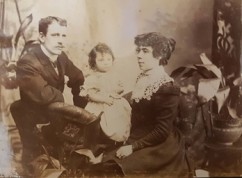
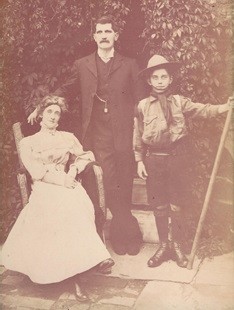 Left: Laura Helstrip with Ted and Maude
Left: Laura Helstrip with Ted and Maude
Right: George and Lydia Helstrip
There were six sisters altogether, all born in York to the Temple family of the Groves, between 1862 and 1876. All married, including Lydia, who married George Helstrip, Alex’s great-grandfather. Intriguingly when we looked at the marriage certificates, Laura and Lydia married on the same day in September 1896, at the same church, St Thomas’s, in the Groves, a double wedding. So it is particularly tragic that they died together almost 50 years later, Lydia (80) and Laura (74).
We did have a puzzle about Nunthorpe Grove. On the eastern side the house numbers jump from 13 to 19, and we always thought that this was something to do with rebuilding following the 1942 disaster. But then we noticed that these two houses were also missing in the 1939 Register, ie before the war, and that most of the families in nos 19-25 had stayed the same both before and after the war, so there had been no renumbering.
Looking at old maps we did have a theory about the reason for the missing numbers, as the houses at this end seemed to change from semi-detached to detached houses early on. We were able to ask a local resident about this, whose family had bought one of the houses from new in 1936. He confirmed that although the original plans (and therefore the numbering) were for all semi-detached blocks, his grandad (alongside another purchaser) both specifically requested detached houses instead, so the estate plans were amended – two semi-detached blocks (four houses) changed to two detached. This would account for the missing two odd numbers (15 & 17) as the blocks were re-numbered from the Southlands Road end, resuming at 19 and missing out 15 & 17.
Update |
Since we published this post we've heard from the family of Neville Bycroft, who lived at 26 Nunthorpe Grove, one of the houses that was destroyed in 1945. He was 11 at the time and remembers it very clearly. His account paints a picture of what it was like at the time:“I was on my paper round, about 4.30pm, delivering the York Evening Press, and we could all see the plane spiralling and parachutes in the air. I realised it was coming down near our house, so I dashed back to the newsagent on Bishopthorpe Road, run by Mrs Cundall (she had been my schoolteacher at Cherry Street infants school) and just left the papers.I ran home to find the house had gone. It was about 5.00pm. Luckily my father, Eddie Bycroft, a foreman at Terry's, was still at work. My mother, Gladys, was out shopping for tea and my younger sister, Audrey, was down the street playing in a friend's front garden.Everything we had was gone. We were sent to the Hall in Moss Street and told to go to live with any relatives we had. Mother, Father and Audrey went to my grandparents, but there wasn’t room for me, so I had to walk to my auntie's house in Tranby Avenue - it was such a long walk but at least I had a bed.I remember the Canadian Air Force sent me a parcel which contained a check lumberjack jacket, which all the lads at Manor School envied. I’d rather have had the house though!The house was rebuilt and the family lived there for many years after”. |

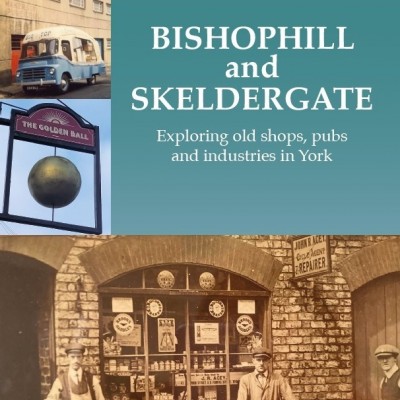
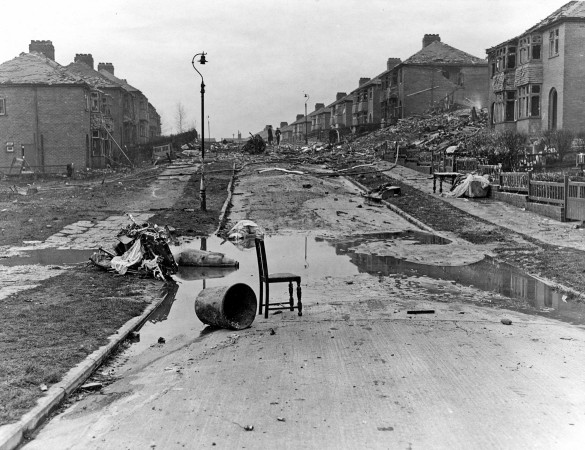
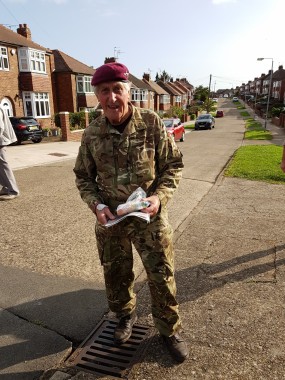 Today we were delighted to welcome Jeffrey Long, 88, a veteran charity fund-raiser and MBE, on his trek to lay a wooden cross at the site in Nunthorpe Grove where the Halifax crashed. The 11-mile walk was part of a series of walks he is doing, totalling 100 miles in all, to raise money for the RAF Benevolent Fund and the RNLI.
Today we were delighted to welcome Jeffrey Long, 88, a veteran charity fund-raiser and MBE, on his trek to lay a wooden cross at the site in Nunthorpe Grove where the Halifax crashed. The 11-mile walk was part of a series of walks he is doing, totalling 100 miles in all, to raise money for the RAF Benevolent Fund and the RNLI.
